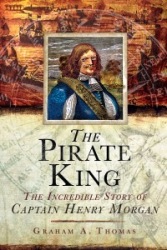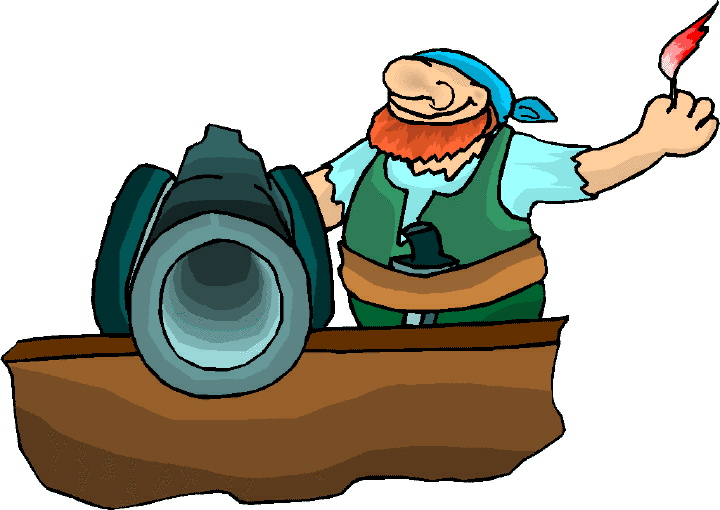 Pirates and Privateers Pirates and Privateers
The History of Maritime
Piracy
Cindy Vallar, Editor
& Reviewer
P.O. Box 425,
Keller, TX 76244-0425
    
Books for Adults ~ Biography:
Pirates, Privateers, & Pirate Hunters
Blackbeard
Captain
Kidd
Pirate Hunter
Pirate Killers
Pirate King

Pirate Hunter: The Life of Captain Woodes Rogers
By Graham A. Thomas
Pen & Sword, 2009, ISBN 978-1-84415-808-9, UK
£19.99
    
While
most books on Caribbean piracy focus attention on
pirates, Pirate Hunter is like a breath of
fresh air. It focuses not on the villains, but on
a hero – a man who defeated the pirates. During
the fifty plus years that he lived, Woodes Rogers
circumnavigated the seas, captured a treasure
galleon, became Governor of the Bahamas, and
turned the pirate haven of New Providence into a
place where the sea rogues weren’t welcome. He
believed so much in what he did that he ended up
in a debtor’s prison because he used his own funds
to make the Bahamas a place where honest citizens
were welcome when royal funds failed to
materialize.
The book opens with
a look at the Rogers family and what little is
known about this privateer’s personal life before
he sets out on his voyage around the world. Half
of the chapters explore this trip in greater
detail and include episodes such as the rescue of
Alexander Selkirk (whose marooning became the
basis for Daniel Defoe’s Robinson Crusoe),
the sacking of Guayaquil, and the capture of one
of the Manila galleons laden with treasure. Among
the personages who appear here are Dr. Thomas
Dover and William Dampier. The second half of the
book focuses on Rogers’s two stints as governor
and how he managed to wrest New Providence from
the pirates.
Three appendices accompany the book: an account of
William Whaling’s trial, one of Rogers’s letters
to the king, and a short piece about navigational
aids. The book concludes with notes, a list of
books to read, and an index. Black-&-white
photographs are also included.
This man’s amazing story unfolds through Thomas’s
deftly worded narrative and Rogers’s own journals
and letters. This is an absorbing and compelling
account of a man often mentioned, but rarely
examined in any detail. No study on the Golden Age
of Piracy is complete without this title.
Review
Copyright ©2009 Cindy Vallar


Pirate Killers: The Royal Navy and
the African Pirates
By Graham A. Thomas
Pen & Sword, 2011, ISBN 978-1-84884-240-3,
UK £19.99 / US $26.37 / CAN $23.86
    
Too often books
on maritime piracy focus on the pirates,
rather than the men who combat them.
Thomas’s latest book does just that as he
relates the history of the British Royal
Navy’s (RN) fight to curb these villains.
From the 17th century to today, he
examines how the RN was instrumental in
going after these rogues regardless of
whether they frequented the north, east,
or west coasts of Africa. Primary coverage
is given to Madagascar, Bartholomew
Roberts’s crew, the Algerian corsairs, and
the Reef (Riff) pirates of Morocco. He
introduces readers to men like
Vice-Admiral Sir Thomas Allin, Sir Edward
Spragge, Sir John Narbrough, Admiral
Arthur Herbert, Captain Challoner Ogle,
Admiral Sir Charles Napier, Admiral Lord
Exmouth (Sir Thomas Pellew), and the men
who served under these officers.
Six appendices supplement the
narrative: Survey of the Reef Coast; Reef
Pirate Activity and the Navy’s Response;
Conversation between British Consul at
Tangier and Reefian Pirates; Letter from
Seaman John Foster; Pirates Executed at
Cape Coast Castle by Admiralty Court; and
Chronology Leading up to the Battle of
Algiers. The book also contains chapter
notes, a recommended reading list, and an
index.
Pirate Killers is an
enlightening account of piracy around a
single continent and how the men and
officers of the British Royal Navy played
a vital role in curbing these sea robbers
of the past, as well as how they continue
to risk their lives to protect seamen and
ships off Somalia today. Much of the
material will be new to readers interested
in piracy; those books that have covered
some of these topics rarely go into the
depth as Thomas does. This isn’t an
academic study, but one lay readers
interested in piracy around Africa will
find fascinating.
Review
Copyright ©2011 Cindy Vallar


The Pirate King: The
Incredible Story of the Real Captain Morgan
By Graham A. Thomas
ISBN 9781632205124, Skyhorse Publishing,
2015, $24.99
review by Irwin Bryan
This book was originally
published as The Buccaneer King in
2014 in the United Kingdom. It tells the
story of the man who led several
incredible buccaneer raids against Spanish
cities in the New World during the late
1600s. Thomas is not the first person to
write about Henry Morgan and his exploits.
This book is specifically intended to
examine “the man himself and the times in
which he lived.” (x) Morgan was “a
brilliant tactician and strategist,” the
author states, whose “closest rival to the
deeds of Morgan” was Admiral Horatio
Nelson himself! (3)
Overall, Thomas attempts to resolve how
Morgan could be a “ruthless man capable of
bringing so much misery and misfortune to
his enemies with the man who was devoted
to his wife and family and who was given
one of the highest offices in the thriving
colony of Jamaica.” (7) By looking at his
actions, at the time, and official sources
and correspondences, Thomas attempts to
resolve this.
One key point in this
examination is that Morgan always had a
commission from the government to defend
Jamaica and do harm to their enemies, the
Spanish. In his eyes, and according to
English laws, he was a privateer. The
English and French who raided Spanish
ships and territories were all historicallyconsidered
“buccaneers,” even though some carried
commissions as privateers and others were
actually pirates. In truth, many were both
at one time or another. But Morgan always
raided under the veil of legality. Indeed,
the title of this edition was probably
changed to The Pirate King due to
Americans’ fascination with pirates.
In 1654, Morgan left Britain as
part of a force led by General Robert
Venables to take Cuba and Hispaniola from
the Spanish. Failing to accomplish this
and with one-third of his troops dead from
sickness, Venables next attacked and
overwhelmed the Spanish on Jamaica.
Although in control, there was continued
fighting against Spanish forces and
guerillas that remained on the island.
Morgan continued to hone his skills at
land warfare and also became a privateer
under Commodore Christopher Myngs. As a
captain Morgan distinguished himself by
taking three ships on a single raid. He
became friends with those who became
captains of these captured ships and was
the most popular and daring privateer of
them all.
Without any naval forces, the governor of
Jamaica needed the presence and loyalty of
the privateers to protect against Spanish
aggression. Sometimes this was against the
will and orders of the king and
politicians in Britain. Nonetheless,
commissions to attack nearby Spanish
possessions were often awarded. Near the end
of 1663, Morgan and three of his fellow
captains and 200 men sailed from Jamaica
with valid commissions and great secrecy.
It was two years before they returned to
Port Royal with holds stuffed with
treasure taken in three successful raids.
Morgan gathered intelligence from Spanish
prisoners, formed alliances with Indians,
navigated inland waterways, and attacked
with complete surprise by making wide
detours to avoid detection. After
plundering Villahermosa, Mexico, forty
miles inland, they returned to the mouth
of the river only to find the Spaniards
had taken their ships and were ready to
attack. Thanks to their superior weapons
and having their backs to the wall, the
buccaneers defeated the Spanish, but were
left without their ships. Where others
might have gone to hide in the
countryside, Morgan and his men used four
canoes and two barques to continue their
raiding. They crossed the Bay of Honduras,
took the town of Truxillo and a vessel
that was there, and travelled by canoe
thirty-seven miles up the Nicaragua River
to attack Grenada. Even then,
Grenada was not a town, but a great city
with seven churches, a cathedral,
colleges, and six companies of Spanish
troops! Within hours the town was captured
and plundered.
Almost all of those who left with Morgan
returned twenty-two months later as rich
men. Morgan’s success led to owning a
plantation and getting married. He became
close with Governor Thomas Modyford and
the leading men of Jamaica.
After he was named Admiral of the Brethren
of the Coast, as the buccaneers were
called, Morgan announced a rendezvous away
from Jamaica and prying ears. One of the men
who joined him at this time, and a chief
source of information, was Alexandre
Exquemelin, also known as John
Esquemeling. While he is suspected to have
embellished his work at times, another
Morgan biographer, Stephen Talty, claims
Exquemelin’s account is verified by
Spanish documents and Morgan’s reports.
Thomas tells of Morgan’s raids on Puerto
del Principe, Portobello, and Panama. He
asserts Morgan’s charisma and oratory
skills enabled him to lead men who had no
particular loyalty to himself, Jamaica, or
Britain. As in his earlier raids, he
gathers intelligence and uses local
Indians to try surprising the places he
raids. When this fails, the buccaneers are
able to avoid or overcome Spanish forces,
but the inhabitants flee with most of
their valuables, reducing the amount of
plunder obtained and increasing the time a
city must be held while the buccaneers
search the countryside for more loot.
In later years Morgan acquired more land
and, when possible, pushed for the
strengthening of Jamaica’s defenses. He
also worked to suppress the continued
piracy and privateering because he knew
the encouragement of trade was the best
way for the island to flourish.
In relating the stories of these raids,
Thomas questions decisions Morgan made. He
wonders why Morgan didn’t lead the advance
party sent to overcome the fort at Chagres
before the attack on Panama and uses
hindsight in chastising him for not
bringing more provisions on the long
journey to Panama. In other
instances he skips over the detailed ways
Morgan improvised and deceived the
Spaniards. The brilliant things he did to
fool and overcome the Spanish fleet that
blocked the buccaneers at Lake Maracaibo,
and how the buccaneers later sailed past
the fort there without being destroyed by
the many cannons covering the exit, are
amazing and show Morgan at the pinnacle of
his tactical genius.
Too much attention is paid to Morgan’s
involvement in politics and the way he was
received in London as a hero instead of a
prisoner. Certainly it takes an amazing
man to have arrived as a prisoner and then
leave with a knighthood and appointment as
lieutenant-governor of Jamaica. Too much
coverage is given to conflicts with future
governors and those same governors’
disagreements with the island’s council.
In evaluating the author’s efforts and the
book itself, I must admit direct quotes
from Dudley Pope’s Harry Morgan’s Way
and Stephen Talty’s Empire of Blue
Water were used so often I found
myself wondering why Thomas decided to
write his own biography of Morgan. Even in
his final summation he uses a direct quote
by Talty to define the man. The skirmishes
and battles Morgan engaged in are
summarized and very matter-of-fact. The
only new information brought to light in
this tome is the politics.
Review
Copyright ©2016 Irwin Bryan


Click to contact me
Background image compliments
of Anke's Graphics |



